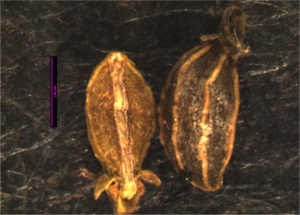Perideridia montana
- Latin Name: Perideridia montana
- Family: Apiaceae
- Common Names: mountain yampah, Gaidner's yampah
- Synonyms/Misapplications: Perideridia gairdneri (misapplied, Mathias, in previous Flora), Atenia montana, Carum garrettii, Carum montanum, P. g. subsp. bolanderi
- Codon: PERMON
Contents
Taxonomy
| Perideridia montana | |
|---|---|
| Scientific classification | |
| Kingdom: | Plantae |
| Subkingdom: | Tracheobionta |
| Phylum: | Spermatophyta |
| Subphylum: | Magnoliophyta |
| Class: | Magnoliopsida |
| Subclass: | Asteranae |
| Order: | Apiales |
| Family: | Apiaceae |
| Genus: | Perideridia Richb. |
| Species: | Perideridia montana (Blank.) Dorn |
Description
Fruit: Fruit glabrous, sub-orbicular, 2-3 mm. long and wide, with prominent ribs.
Bloom Period
July to August[1]
Distribution
Southern BC south, on both sides of Cascades, to southern California, east to northern Great Plains, Wyoming and Colorado.[2]
Habitat
Perideridia gairdneri prefers well-drained, nitrogen medium soils. It tolerates slightly acid to mildly alkaline soils. It is very shade intolerant. It is a climax species in drier sites, and is found in the meadow communities in Garry oak ecosystems. Grows from low to middle elevations.
Uses
Propagation
The Seed
Seed sample from 2011
Features
Average Measurement: 2.3 x 1 x 1
Measurement Range: L: 1.5 – 3, W: 0.8 – 1.1, D: 0.75 – 1.3
Latitudinal Cross Section: ovate
Longitudinal Cross Section: elliptical
Shape: Seed schizoid, flat on one plane, and rounded on the opposite plane. Lots of irregularity in shape.
Color: Various shades of green and brown. Hilum usually white. Some seeds have pink from remnant flower structure at apex opposite hilum.
Surface: Seeds have five ridges on outer seed face that run from hilum to opposite apex longitudinally. Inner seed face has one white rib that bisects the seed face.
Basic Explanations and Assumptions:
The dimensions for the seeds are length x width x depth. The location of the hilum is used as the base of the seed, and the length is measured from hilum to the opposite apex. Where a style is present, the length is measured from the hilum to the bottom of the style. Width is measured at a right angle to the length at the widest part. Depth is measured at a right angle to the intersection of height and width lines.
Measurements included are the mean average for each measurement of ten separate seeds.
All measurements in millimeters unless otherwise noted.
Photo Gallery
References
- ↑ WTU Herbarium, Burke Museum, & University of Washington. Retrieved from https://biology.burke.washington.edu/herbarium/imagecollection/taxon.php?Taxon=Perideridia%20montana
- ↑ Hitchcock, C. L., Cronquist, A., Giblin, D., & Legler, B. et al. (2018). Flora of the Pacific Northwest: an illustrated manual. Seattle: University of Washington Press.

